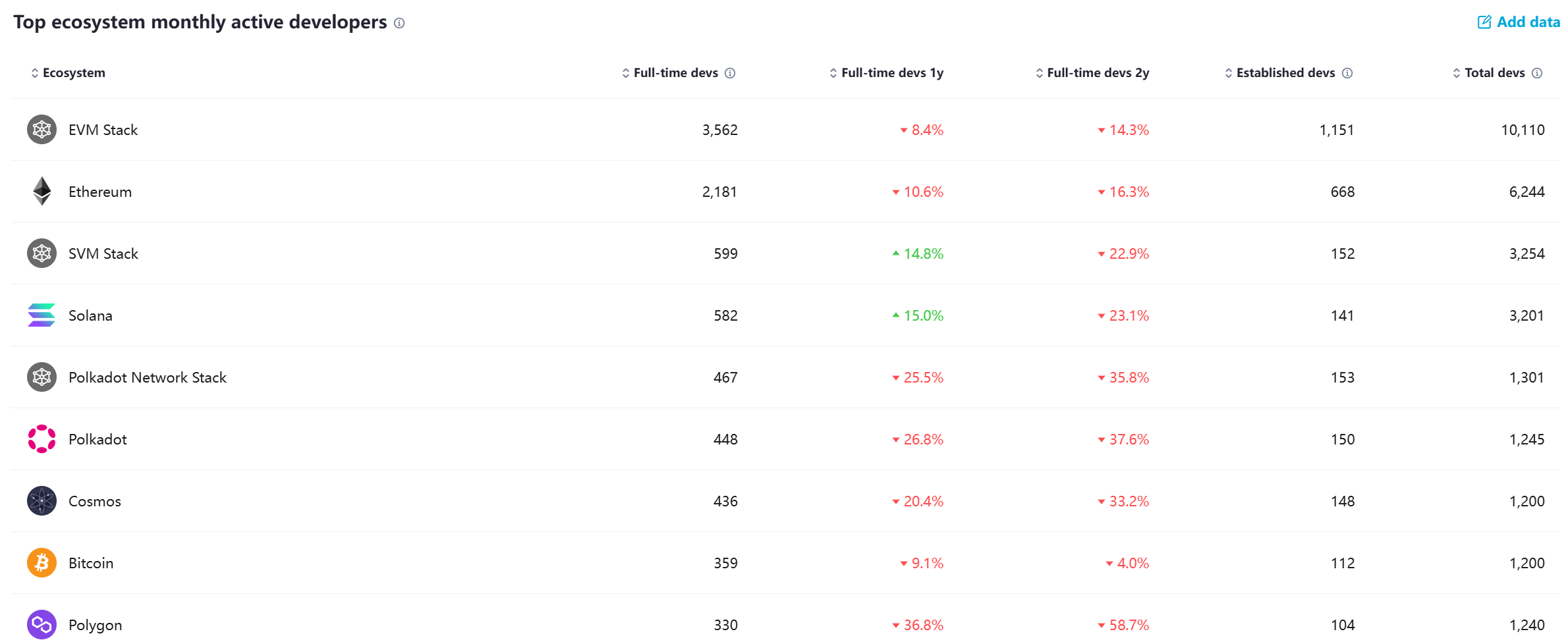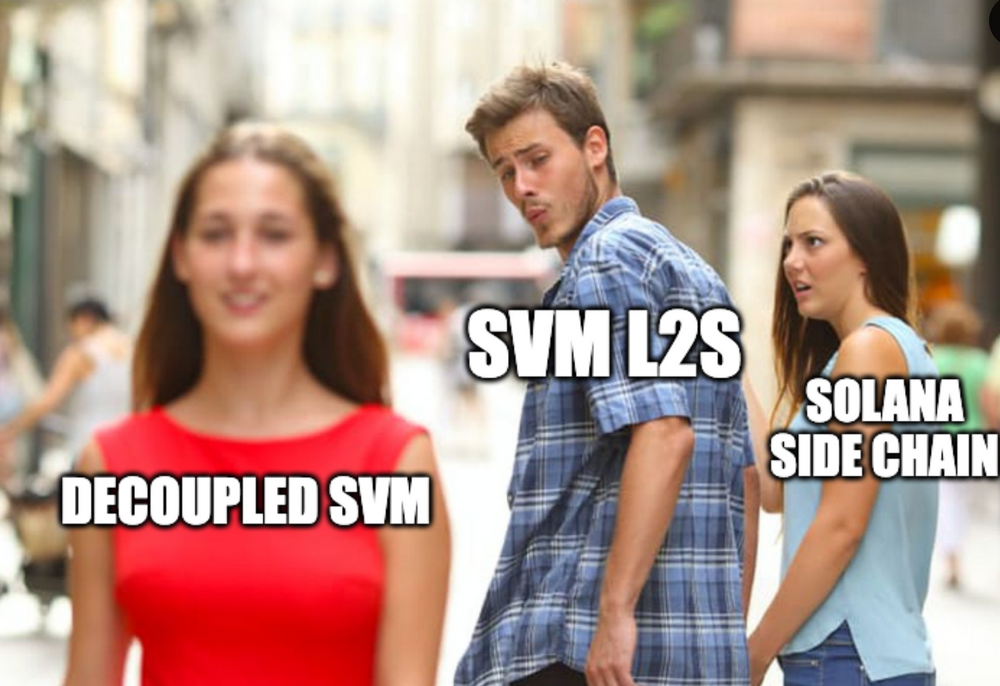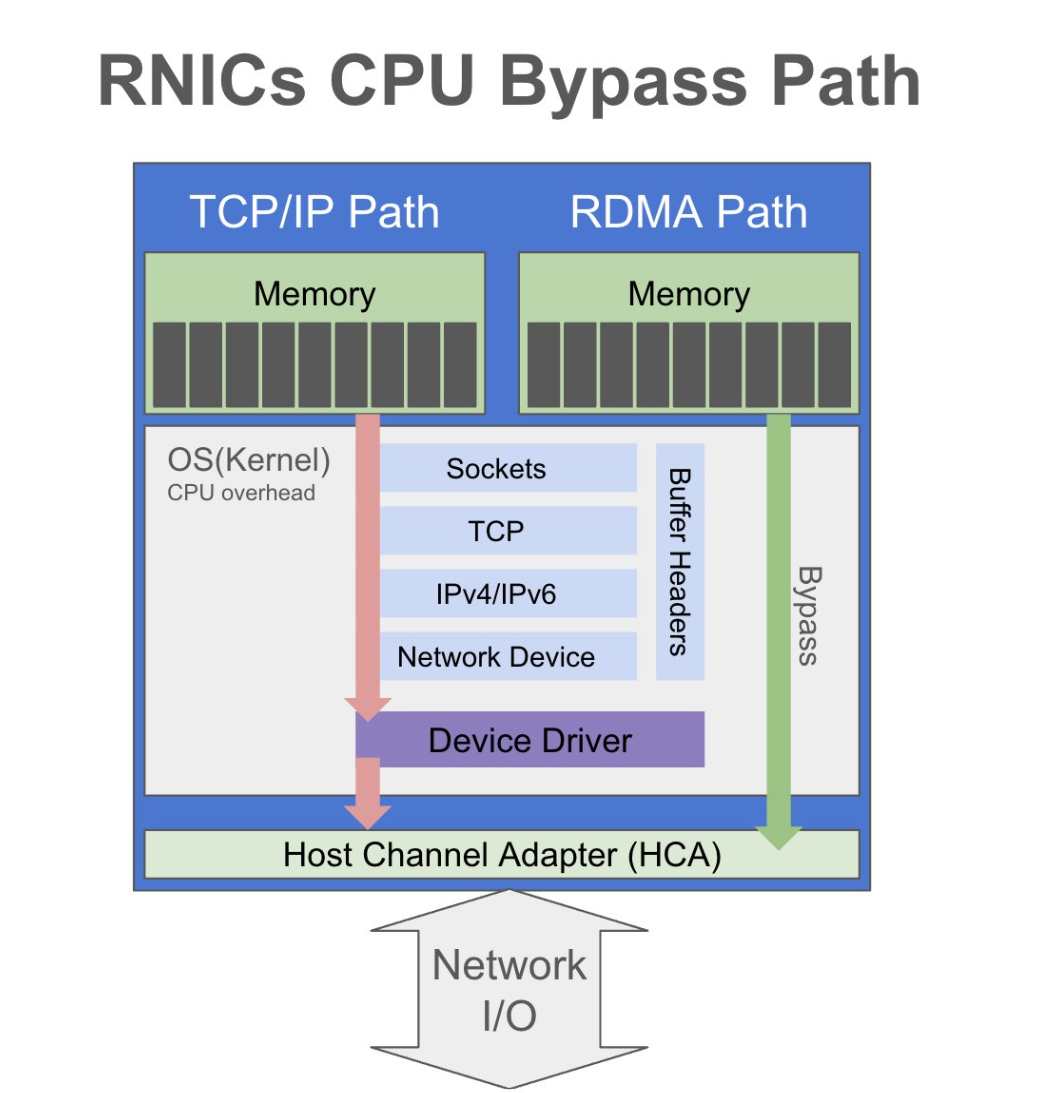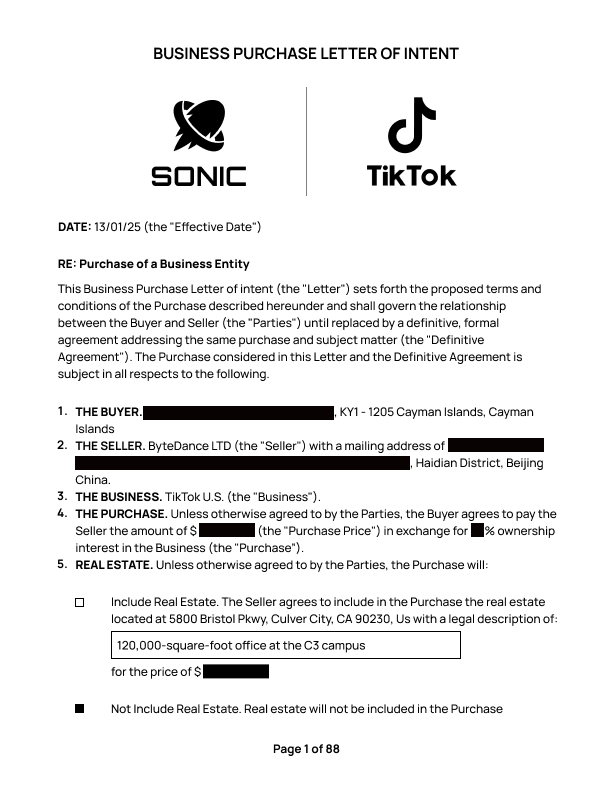Disassembly the SVM arms race: Perspective of the battle for top students of Solayer, SOON, Sonic SVM

Reprinted from panewslab
02/10/2025·14DAuthor: JiaYi
What would the Crypto world look like if Ethereum reached 10,000 TPS or higher in another parallel universe?
As the new "seed player" of the Solana ecosystem that is most highly anticipated in 2025, Solana Virtual Machine (SVM) seems to be gradually reflecting this assumption into reality through three breakers - Sonic, SOON, and Solayer.
Especially in the context of the urgent need to take over the new Solana narrative in 2025, these three top players in the SVM ecosystem are trying to answer the "high concurrency, low latency, cross-chain compatibility" industries with differentiated technical paths. The ultimate proposition, this article will also disassemble the deep logic of this SVM arms race from the three dimensions of underlying architecture, ecological strategy and market positioning.
Why is SVM important in 2025?
"I am an Ethereum killer, making money." With the era of new public chains easily enclosing land, financing and speculation in 2018-2020, few people have mentioned "Ethereum killer" in recent years. ”Narration.
To put it bluntly, games that simply copy EVM architecture + TPS numbers can no longer meet the evolutionary needs of Web3 - According to the Electric Capital developer report, among the fastest cryptocurrency ecosystems with new developers in 2024, EigenLayer, Aptos, and Solana are ranked. The top three saw growth reaching 167%, 96% and 83%.
In terms of developer share, Ethereum is still the largest ecosystem on every continent, but Solana, ranked second, is the first ecosystem of choice for new developers . This is also the first to attract new developers since 2016. An ecosystem of more new developers than Ethereum.

This transformation reflects a profound change in industry perception: the blockchain war has shifted from a "narrative battle" to an "executive environmental revolution", especially after Solana Virtual Machine (SVM) has completed architectural upgrades and the influx of new developers. , the essence is not to replace a certain public chain, but to reconstruct the technical paradigm of the entire smart contract execution layer.
So what exactly is SVM? Its full name is Solana Virtual Machine, and it is an execution environment that handles transactions, smart contracts and programs on the Solana network. It is designed to solve specific scaling and user experience problems.
As we all know, traditional EVM (Ethereum virtual machine) does a good job in compatibility, but in high-frequency application scenarios, such as games, DeFi, social networks, etc., the performance often cannot keep up. SVM takes Solana's core performance as Base, providing extremely fast transaction speeds and lower gas fees.
The most critical SVM supports parallel processing of transactions, unlike EVMs, which have to queue up to process one by one (just like there is only one cashier during peak shopping). The advantage is that multiple transactions run at the same time, and the high demand period is still fast, and the handling fee is still low .
When Solana ecosystem nurtures SVM and Sui and Aptos build MoveVM, the technological evolution of the Crypto ecosystem presents a clear strategic roadmap: the core battlefield of the next generation of blockchain war is shifting from a consensus layer to execution environment innovation.
SVM itself is a further extension of Solana 's influence - the better SVM does, the greater Solana's influence.
The technical path and ecological ambition of SVM three masters
SOON: SVM 's Movement
In terms of objective comparison, SOON 's positioning is more like "Movement in SVM", which means that it is preferred to be close to the community in construction . At the same time, a relatively different point lies in completing financing through co-constructor rounds and community fair start-up mode. .
So if Movement brings Move to Ethereum, then SOON is going to go a step further and brings SVM to all L1s: And it is quite different from the imagined "Solana L2". It does not rely on the Solana main network, but rather Provides flexible scaling capabilities through SOON Stack, allowing SVMs to be deployed on other mainstream Layer1s .
This design allows any public chain ecosystem to enjoy the advantages of SVM, including faster transaction speeds and lower Gas fees. Therefore, SOON and other SVMs face completely different execution environments, which requires more High-performance Rollup and technology stack to assist.
After all, the multi-chain prosperity of the pan-EVM ecosystem forces developers to re-create wheels (one project is deployed multiple chains), resulting in a decline in product quality and users are tired. SOON is considered to use a unified environment to concentrate resources, but in fact, it greatly optimizes development. experience of the person.
Let’s talk about the fee issue, Ethereum’s “global charging model” is really not considerate – a popular NFT auction can push up the cost of your ordinary transactions. In contrast, SOON’s localized fee market is wonderful: it should be spent. Spend as much as you want, and do not interfere with each other.

At the same time, the SOON private equity round also attracted a number of well-known projects, including Solana, Celestia, etc., and allocated 51% of the tokens to NFT buyers, and also provided feedback on the community's opinions as soon as possible. This also means that It coincides with Movement’s idea - value the community and is willing to listen to the community, and ultimately jointly promote the success of the project and enjoy the positive effects it brings.
Judging from the actual project progress, SOON development progress is also the fastest among the three SVM masters. To some extent, SOON is not just the "king of volumes", its design is actually solving the "old problems" of EVM and Solana. If you are a market operator, you might as well learn some tricks from its community and resource concentration methods - win-win results and win-win situations are not dreams~
Solayer: I have to TVL, I have to be efficient.
In the past year, Solayer's narrative switching has been textbook-level: from "re-staking protocol" to "RWA stablecoin" to "hardware-accelerated SVM", every time it accurately hits the market hot spots.
I have always said before that the team's cognition and execution ability and luck are finally the small version of the project. Founders Rachel (formerly Sushiswap core development) and Jason (founder of MPCVault) have a sense of product and technology, and acquired Fuzzland reinforcement chain Safety can be seen - fast narrative switching, strong financing, and full execution.
I first heard that Solayer was more than a year ago, when EigenLayer became popular, and Solayer emerged, focusing on the pledge direction on Solana, benchmarking it as the "Solana version of EigenLayer".
Because of this, Solayer started in Staking ecosystem of SOL, especially Solana-based staking data and infrastructure, which laid a solid initial foundation. However, the latest updates show that Solayer is no longer limited to staking, but has begun to get involved. SVM technology track.

What is the core competitiveness of a project that started with pledge after entering the field of SVM technology?
In fact, there is a key node that cannot be ignored. Solayer acquired the technology company FuzzLand and jointly created Solayer InfiniSVM. It is precisely because of this opportunity and a tool that Solayer has started a new narrative planning layout and aimed at the first implementation. The public chain of hardware acceleration expansion solutions will ultimately realize the high-speed public chain:
Solayer's 2025 roadmap proposes "Infiniband RDMA technology" with a target of millions of TPS+100 Gbps, and its hardware acceleration claims that it is responsible for sorting from transactions by offloading key operations of blockchains to specialized hardware components . Scheduled to storage and other operations, so that 1 millisecond transaction confirmation can be achieved. If the technical solution can be implemented, it is indeed expected to achieve a large-scale crushing Monad.
To be simple, in Solayer Chain, each transaction follows a workflow. The transaction will first enter a scalable inlet cluster consisting of hundreds of thousands to millions of nodes , which will be based on the probability of future states. Predictions clean and pre-execute transactions.
All execution snapshots are then sent to a sorter built by Intel Tofino switches and additional FPGAs, and it is worth noting that most transactions are already confirmed to be valid in the pre-execution phase, so there is no need to execute again on the sorter.
Can't understand? It doesn't matter, now there is a simple example for you to understand:
- Imagine you line up for security checks at an airport, and everyone's luggage will be scanned by the machine (corresponding to the cleaning and pre-execution phase of the transaction). Most luggage is generally free of problems and can be released directly;
- But if the machine finds a suspected problem with a luggage (conflict transaction), it will be sent to a more advanced checkpoint for detailed inspection (sorting and re-execution), which is equipped with top-level inspection equipment and professionals (Intel Tofino switches and FPGAs) ensure that luggage inspection is efficient and fair;
- In this airport, a simple luggage check can process 16 billion pieces per second (TPS for simple transactions); even if the luggage encountered problems, it can process 890,000 pieces per second (TPS for conflict transactions);
- In other words, airports (SVMs of solayers) can simultaneously handle routine luggage checks for billions of passengers and complex checks for millions of problem luggage in one second, ensuring efficiency and taking into account special circumstances;
Like the SOON mentioned above, Solayer has also been recognized by Solana and major institutions. The two rounds of financing include Solana co-founder toly, and has attracted top-notch ones including Binance Labs (now YZi Labs) and Polychain. Organizational support.
Sonic SVM: The "breaking engine" of chain game infrastructure
Sonic SVM is the earliest TGE project in the SVM track, and has been launched on spot stocks on most mainstream exchanges except Binance.
Unlike the SVM project mentioned above, Sonic SVM focuses on the game -innovative design mainly targets high concurrency and instantaneous transaction needs in game scenarios.
Among them, the entire Sonic SVM technology is built on the HyperGrid framework. HyperGrid is also Solana's first concurrent expansion framework. The original design intention is to achieve high customization and scalability while maintaining native composability with Solana.
Because HyperGrid supports developers to write applications in the EVM environment, but ultimately executes on Solana, the settlement layer is still Solana , so it is more convenient for developers to write projects in existing familiar programming languages, reducing the ability to get started with the new public chain to understand the new one time.
It is worth mentioning that Sonic SVM is the first Grid instance in the HyperGrid framework - is it very similar to the relationship between Virtuals and Luna?
In addition, Sonic's Guardian Nodes system focuses on verification of on-chain user behavior. Through this mechanism, it effectively prevents robot attacks and malicious behaviors, provides gamers with a safer interactive environment, and the operation of nodes also provides guarantees for the stability of network performance. .

Another key highlight of Sonic is its TikTok Mini App - SonicX. With the help of TikTok's huge user base, SonicX generates a wallet bound to the TikTok account for users through a simple login method, thus achieving seamless account abstraction.
This design greatly lowers the entry threshold for Web3, allowing ordinary users to participate in various activities of chain games without understanding the private key and on-chain operations (Go to tell me, TikTok is currently facing policy risks in Europe and the United States, and the traffic prospects are always concealed There is a shadow, so whether this new channel can work for a long time is a challenge).
Overall, the three major projects in the SVM track have their own characteristics:
- Sonic SVM : Through TikTok traffic diversion and on-chain seamless interaction mode, focus on the chain game experience;
- Solayer : Focus on higher performance efficiency improvement, and combine the original re-staking and liquidity optimization to expand the ecosystem;
- SOON : Focusing on a community-based approach to learning the idea of Movement to expand SVM to the entire blockchain world;
Conclusion
The strong wind rises at the end of the Qingping. Behind every successful issuance of coins, an important clue is often revealed: the infrastructure needed by the market is being redefined!
From DeFi to chain games, to social applications, users have increasingly strong demand for "fast, low-cost, and high-experience". In this process, the bottlenecks of traditional EVM gradually emerge. It is precisely because of these limitations that SVM innovation is particularly important.

 chaincatcher
chaincatcher

 jinse
jinse